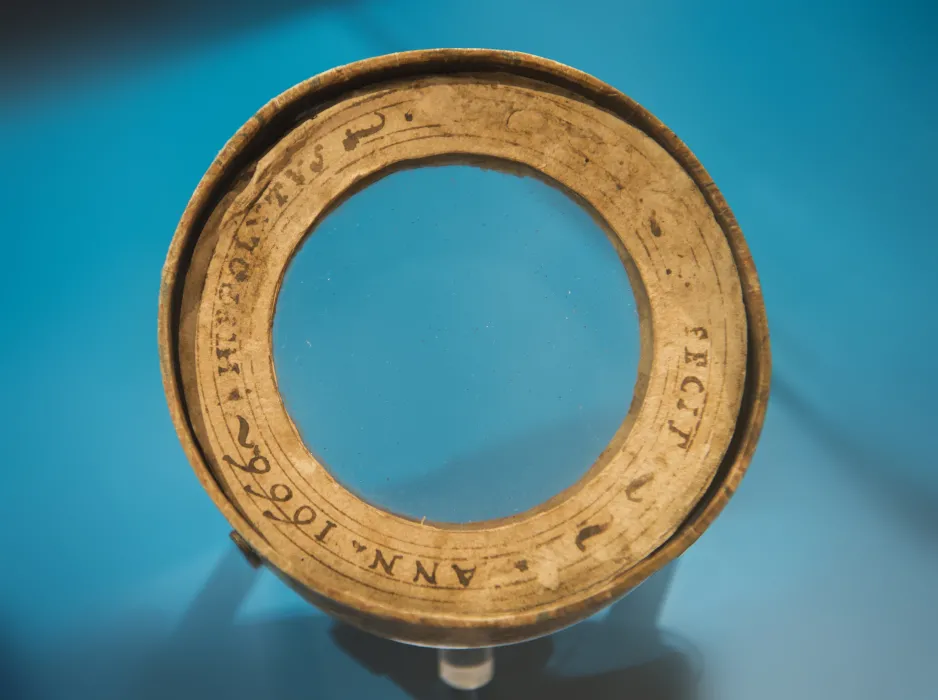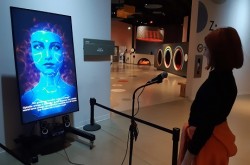Dans les coulisses : Les prêts d’artefact exigent que tout le monde participe

Lorsqu’un musée prête un de ses précieux artefacts à un autre établissement, c’est un peu comme envoyer un enfant dans un camp d’été.
Voilà l’ingénieuse analogie qu’utilise Erin Secord pour expliquer les rapports sur l’état de conservation qu’elle doit envoyer au Museo Galileo de Florence, en Italie, sur un ancien télescope en exposition au Musée des sciences et de la technologie pendant les prochains mois.
« C’est un peu comme envoyer votre enfant dans un camp d’été. Vous l’envoyez avec tout plein de directives et vous vous attendez à avoir des nouvelles du camp d’été si quelque chose ne va pas », explique Mme Secord.
Dans le cas du télescope, un artefact extrêmement fragile et précieux qui date de 1665, le Museo Galileo se préoccupe particulièrement de son cylindre et de son disque de papier.
« Il y a un cylindre au bout du tube qui soutient la lentille et un disque en papier avec la lentille dessus, dit Mme Secord. Le disque en papier est maintenu en place à l’aide d’un rouleau de cuivre, un ressort. »
Le papier est très fragile, donc chaque mois Mme Secord doit envoyer de nouvelles photos de cette section du télescope au Museo Galileo. Les photos sont ensuite étudiées par le Museo Galileo pour s’assurer que le rouleau n’endommage pas davantage le papier.

Erin Secord effectue régulièrement des rapports sur l’état de cette lentille en papier, une pièce d’un télescope actuellement prêté par l’Italie.
“It’s a continuous feedback loop with the lender,” says Secord. “It’s a babysitting report at the end of the day; we expect it from other institutions, other institutions expect it from us. Even though this loan is from Italy, we treat this loan the same way we would treat others – whether they’re from Montreal, Vancouver, or somewhere else in Ottawa.”
While the condition reports may be standard protocol, there were a number of special arrangements that the museum had to make in order to accommodate the telescope on international loan. In fact, Secord estimates that preparations began at least 18 months before the telescope travelled to Ottawa last fall.
One notable project was the building and installation of an impressive display case to house the telescope.
“The museum’s design build team had to decide how to make this case,” says Secord, adding that they drew from the extensive experience of the Museo Galileo’s curator, Giorgio Strano, to determine the case’s dimensions.
The telescope can be compacted and expanded; it was small when it arrived in Ottawa. The museum consulted with Strano to determine how far it should be extended while on display.
“Giorgio himself pulled it all apart,” says Secord. “After 500 years, some nested cylinders of the telescope are no longer movable, some probably stick together – and he knows which ones come apart.”
The completed display case measures just over 2.75 m in length, 86 cm wide, and stands 93 cm tall.
“We built the case to be flexible for globes and artifacts of different shapes that the curators may wish to display,” says Secord, thinking ahead to what other artifacts may find a home in the custom case in the future.
Since it’s essential for the telescope to have a climate-controlled environment, the case also had to be specially equipped to measure and maintain proper humidity levels.
“We have a conduit that provides relative humidity-conditioned air, which is at about 45 per cent relative humidity,” explains Secord. This is crucial, as visitors to the museum drives up the relative humidity in the air.
“As people come in here, the relative humidity of the museum with go up,” says Secord. “A human will – In the course of a day, release a pint of water into the air.”
The display case is sealed, so the environment inside is stable. It is also fitted with very low light; within the case, lighting stays at 50 lux (with lux being the measure of luminous flux per unit area).
“You’ll notice that it’s quite dark in here,” says Secord of the display case. “We already have no UV light in the museum, because it fades papers, fabrics, and other coloured materials – and fading is irreparable damage.”
The team also paid careful attention to how the telescope would be presented inside the case.
“In order for us to be able to display it in a way that allows people to see all the surfaces of it – we didn’t just want it to be lying flat on the base – Giorgio and our conservation technician, Matthew Bruce, made a special system of cradles based on Giorgio’s dimensions,” says Secord, adding that the cradles were all made of brass and lined with Volara closed-cell archival foam.
In addition, the museum’s carpenter, Paulus Heebink, was tasked with making plinths to raise the telescope, in order to present it at an ideal viewing height within the case.
A team of people with specialized skills worked in tandem to present museum guests with something truly special – a rare telescope that will soon be returning to its home in Italy.
“Behind the scenes, there are so many interwoven processes to prepare for just one artifact,” says Secord. “There’s a ton of people involved and everyone has a part in the machinery that makes it happen.”
























































![Un bloc de photographies montrant quelques-unes des personnes impliquées dans le bombardement des bélugas de l’estuaire et du golfe du fleuve Saint-Laurent. Anon., « La chasse aux marsouins [sic]. » Le Devoir, 15 août 1929, 6.](/sites/default/files/styles/thumbnail_7/public/2024-09/Le%20Devoir%2015%20aout%201929%20page%206.jpg?h=584f1d27&itok=TppdLItg)






